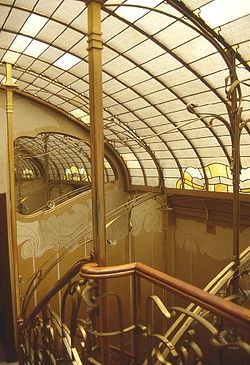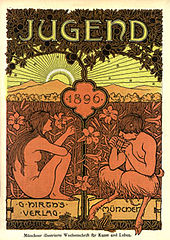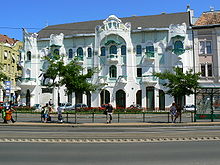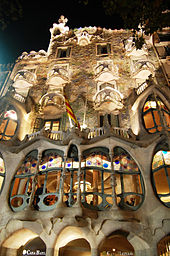Art Nouveau
From Wikipedia, the free encyclopedia

Staircase of the Maison & Atelier of Victor Horta. This building is one of four Horta-designed town houses in Brussels that are together recognised by UNESCO as "representing the highest expression of the influential Art Nouveau style in art and architecture."

A shop in Porto, Portugal, in Art Noveau style and covered in azulejos.
The movement was strongly influenced by Czech artist Alphonse Mucha, when Mucha produced a lithographed poster, which appeared on 1 January 1895 in the streets of Paris as an advertisement for the play Gismonda by Victorien Sardou, starring Sarah Bernhardt. It was an overnight sensation, and announced the new artistic style and its creator to the citizens of Paris. Initially called the Style Mucha, (Mucha Style), this soon became known as Art Nouveau.
Art Nouveau's fifteen-year peak was most strongly felt throughout Europe—from Glasgow to Moscow to Madrid—but its influence was global. Hence, it is known in various guises with frequent localised tendencies. In France, Hector Guimard's metro entrances shaped the landscape of Paris and Emile Gallé was at the center of the school of thought in Nancy. Victor Horta had a decisive impact on architecture in Belgium.
Magazines like Jugend helped spread the style in Germany, especially as a graphic artform, while the Vienna Secessionists influenced art and architecture throughout Austria-Hungary. Art Nouveau was also a movement of distinct individuals such as Gustav Klimt, Charles Rennie Mackintosh, Alphonse Mucha, René Lalique, Antoni Gaudí and Louis Comfort Tiffany, each of whom interpreted it in their own individual manner.
Although Art Nouveau fell out of favour with the arrival of 20th-century modernist styles, it is seen today as an important bridge between the historicism of Neoclassicism and modernism.Furthermore, Art Nouveau monuments are now recognized by UNESCO on their World Heritage List as significant contributions to cultural heritage. The historic center of Riga, Latvia, with "the finest collection of art nouveau buildings in Europe", was inscribed on the list in 1997 in part because of the "quality and the quantity of its Art Nouveau/Jugendstil architecture",and four Brussels town houses by Victor Horta were included in 2000 as "works of human creative genius" that are "outstanding examples of Art Nouveau architecture brilliantly illustrating the transition from the 19th to the 20th century in art, thought, and society".
Contents
|
Naming the style
At its beginning, neither Art Nouveau nor Jugendstil was the common name of the style but was still known as this in some locations, and the style adopted different labels as it spread between artistic centres. Those two names came from, respectively, Samuel Bing's gallery Maison de l'Art Nouveau in Paris and the magazine Jugend in Munich, both of which promoted and popularised the style.Bing's Maison de l'Art Nouveau
Maison de l'Art Nouveau (House of New Art) was the name of the gallery opened in 1895 by the German art dealer Samuel Bing in Paris that marked his exclusive focus on modern art. The fame of his gallery was increased at the 1900 Exposition Universelle, where he presented coordinated—in design and color—installations of modern furniture, tapestries and objets d'art. These fully realised decorative displays became so strongly associated with the style that the name of his gallery subsequently provided a commonly used term for the entire style: Art Nouveau.
This front cover of an 1896 edition of the German magazine Jugend is decorated in Art Nouveau motifs. Jugend was strongly associated with the style and the magazine's name inspired the German term for the movement, Jugendstil ("Jugend"-style).
Jugend and Jugendstil

Jugendstil typography, applied to a brewery sign
Other names
Other local names were associated with the characteristics of its forms, its practitioners and their works, and schools of thought or study where it was popular. Many of these terms refer to the idea of "newness". Before the term "Art Nouveau" became de rigueur in France, le style moderne ("the modern style") was the more frequent designation. Arte joven ("young art) in Spain, Arte nuova ("new art") in Italy, and Nieuwe kunst ("new art") in the Netherlands, модерн ("new", "contemporary") in Russia - all continue this theme. In similar manner, its modern characteristics gave way to the label of Catalan Modernisme in Barcelona. Many names refer specifically to the organic forms that were popular with the Art Nouveau artists: Stile Floreal ("floral style"), Lilienstil ("lily style"), Style Nouille ("noodle style"), Stile Vermicelli ("vermicelli", or "little worm noodle" style), Bandwurmstil ("tapeworm style"), Paling Stijl ("eel style"), and Wellenstil ("wave style").In other cases, important examples, well-known artists, and associated locations influenced the names. Hector Guimard's Paris Métro entrances, for example, provided the term Style Métro, the popularity in Italy of Art Nouveau designs from London's Liberty & Co department store resulted in its being known as the Stile Liberty ("Liberty style"), and, in the United States, it became known as the "Tiffany style" due to its connection to Louis Comfort Tiffany.In Austria, a localized form of Art Nouveau was practised by artists of the Vienna Secession, and it is, therefore, known as the Sezessionstil ("Secession style").As a stand-alone term, however, "Secession" (German: Sezession, Hungarian: szecesszió) is frequently used to describe the general characteristics of Art Nouveau style beyond Vienna, but mostly in areas within the cultural reach of Austria-Hungary at the turn of the 20th century. In the United Kingdom, it is associated with the activities of Charles Rennie Mackintosh in Glasgow, and is often known as the "Glasgow" style.Art Nouveau tendencies were also absorbed into larger local movements. In Denmark, for example, it was one aspect of Skønvirke ("aesthetic activity"), which itself more closely relates to the Arts and Crafts Movement. Likewise, artists adopted many of the floral and organic motifs of Art Nouveau into the Młoda Polska ("Young Poland") movement in Poland. Młoda Polska, however, was also inclusive of other artistic styles and encompassed a broader approach to art, literature and lifestyle.

The book-cover by Arthur Mackmurdo for Wren's City Churches (1883) is often cited as the first realisation of Art Nouveau
Origins
The origins of Art Nouveau are found in the resistance of William Morris to the cluttered compositions and the revival tendencies of the Victorian era and his theoretical approaches that helped initiate the Arts and crafts movement. However, Arthur Mackmurdo's book-cover for Wren's City Churches (1883), with its rhythmic floral patterns, is often considered the first realisation of Art Nouveau. Around the same time, the flat perspective and strong colors of Japanese woodcuts, especially those of Katsushika Hokusai, had a strong effect on the formulation of Art Nouveau's formal language.The wave of Japonisme that swept through Europe in the 1880s and 1890s was particularly influential on many artists with its organic forms, references to the natural world, and clear designs that contrasted strongly with the reigning taste. Besides being adopted by artists like Emile Gallé and James Abbott McNeill Whistler, Japanese-inspired art and design was championed by the businessmen Siegfried Bing and Arthur Lasenby Liberty at their stores in Paris and London, respectively.Character
Although Art Nouveau took on distinctly localised tendencies as its geographic spread increased—discussed below—some general characteristics are indicative of the form. A description published in Pan magazine of Hermann Obrist's wall-hanging Cyclamen (1894) described it as "sudden violent curves generated by the crack of a whip", which became well known during the early spread of Art Nouveau. Subsequently, not only did the work itself become better known as The Whiplash, but the term "whiplash" is frequently applied to the characteristic curves employed by Art Nouveau artists. Such decorative "whiplash" motifs, formed by dynamic, undulating, and flowing lines in a syncopated rhythm, are found throughout the architecture, painting, sculpture, and other forms of Art Nouveau design.Philosophy and geography
Art Nouveau is now considered a 'total' style, meaning that it encompasses a hierarchy of scales in design — architecture; interior design; decorative arts including jewellery, furniture, textiles, household silver and other utensils and lighting; and the range of visual arts. (See Hierarchy of genres.) In the philosophy of the movement, art should be a way of life. For many Europeans, it was possible to live in an art nouveau-inspired house with art nouveau furniture, silverware, crockery, jewellery, cigarette cases, etc. Artists desired to break all connections to classical times and bring down the barriers between the fine arts and applied arts. Art Nouveau was underlined by a particular way of thinking about modern society and new production methods, attempting to redefine the meaning and nature of the work of art so that art would not overlook any everyday object, no matter how utilitarian. Hence the name Art Nouveau - "New Art".International expos
A high point in the evolution of Art Nouveau was the Exposition Universelle of 1900 in Paris, which presented an overview of the 'modern style' in every medium. It achieved further recognition at the Esposizione Internazionale d'Arte Decorativa Moderna of 1902 in Turin, Italy, where designers exhibited from almost every European country where Art Nouveau was practised.Belgium, Switzerland and France

Interior of a dome in the Grand Palais, Paris
Germany

The villa Schutzenberger in Strasbourg, now seat of the European Audiovisual Observatory, was built 1897-1900 by Berninger & Krafft and is considered a superb example of Jugendstil style.
Henry Van de Velde, who worked most of his career in Germany, was a Belgian theorist who influenced many others to continue in this style of graphic art including Peter Behrens, Hermann Obrist and Richard Riemerschmid. August Endell is another notable Art Nouveau designer.
Magazines were important in spreading the visual idiom of Jugendstil, especially the graphical qualities. Besides Jugend, other important ones were the satirical Simplicissimus and Pan.
Austria

The secession building in Vienna was built in 1897 by Joseph Maria Olbrich for exhibitions of the secession group
Malta

The Balluta Buildings
Britain

The Edward Everard building in Bristol, England
Other notable British Art Nouveau designers include Walter Crane, Arthur Lasenby Liberty, Charles Ashbee and Aubrey Beardsley.
The Edward Everard building in Bristol, built in 1900-01 to house the printing works of Edward Everard, features an Art Nouveau façade. The figures depicted are of Johannes Gutenberg and William Morris, both eminent in the field of printing. A winged figure symbolises the Spirit of Light, while a figure holding a lamp and mirror symbolises light and truth.
Hungary

Church of St. Elisabeth in Bratislava, by Ödön Lechner.

Budapest, Museum of Applied Arts

Szeged, Hungary REÖK Palace
Spain

The Casa Batlló, already built in 1877, was remodelled in the Barcelona manifestation of Art Nouveau, modernisme, by Antoni Gaudí and Josep Maria Jujol in 1904–1906
Prague and the Czech lands
The influence of Alphonse Mucha was felt in Prague and Moravia (part of the modern Czech Republic), whose style of Art Nouveau became associated with the Czech National Revival. Fin de siècle sections of Prague reveal modest buildings encrusted with leaves and ladies that curve and swirl across the façades.Examples of Art Nouveau in the city, along with the exteriors of any number of private apartment and commercial buildings, are the Municipal House, the Hotel Pariz, Smíchov Market Hall, Hotel Central, the windows in the St. Wenceslas Chapel at St. Vitus Cathedral, the main railway station, the Grand Hotel and the Jubilee Synagogue. The Olsany Cemetery and the New Jewish Cemetery are also important examples of Art Nouveau.Latvia
Art Nouveau architecture was popular in Riga, the capital of Latvia, in late 19th century and the beginning of 20th century - about 40% of the buildings from this time period were built in this style. Several substyles formed during this period. Early on elements of the new style were added to Eclectic architecture forming "Eclectic" Art Noveau. "Decorative" Art Noveau refers to style making use only of decorative elements of the Art Noveau, first such building was built in 1899, however by 1906 decorative styles had become unfashionable. Therefore the decorative style is not very widespread in Riga. Most popular style in Riga is known as "Romantic" Art Noveau - simplistic and modern in form, these buildings were decorated with elements from other historic styles and constitute about one third of all buildings in the central Riga. From 1905-1911 Latvian National Romantism peaked - while being a substyle of Art Noveau it attempted to copy forms of traditional architecture and incorporated traditional decorative elements. As the Art Noveau matured emphisis on vertical lines became more popular, known as "Vertical" Art Noveau this style was most popular shortly before the WWI. The center of Riga is now designated as UNESCO World Heritage site in part for its Art Noveau architecture.
Central and Eastern Europe
In Russia, the movement revolved around the art magazine Mir iskusstva ('World of Art'), which spawned the revolutionary Ballets Russes.The Polish movement was centred in Krakow and was part of the Mloda Polska movement. Stanisław Wyspiański was the leading Art Nouveau artist in Poland; his paintings, theatrical designs, stained glass, and building interiors are widely admired and celebrated in the National Museum in Kraków. Art Nouveau buildings survive in most Polish cities (Łódź, Kraków), with the exception of Warsaw, where Communist authorities destroyed the few examples that survived the Nazi razing of the city on the grounds that the buildings were decadent.

House Feller, 1906, in Zagreb.
Croatia was an area of secessionist architecture as well. Architects like Vjekoslav Bastl and Baranyai developed a mixture between modernism and classical Art Nouveau.
Other areas
Italy's Stile Liberty reflected the modern design emanating from the Liberty & Co store, a sign both of Art Nouveau's commercial aspect and the 'imported' character that it always retained in Italy.The spread of Art Nouveau in Portugal suffered a delay due to slowly developing industry, although the movement flourished. especially in cities like Oporto and Aveiro, in which can be found numerous buildings influenced by European models, particularly by French architecture.
Art Nouveau was also popular in the Nordic countries, where it became integrated with the National Romantic Style. Good examples are the neighbourhoods of Katajanokka and Ullanlinna in Helsinki, Finland, as well as the Helsinki Central railway station, designed by the architect Eliel Saarinen. As in Germany, Jugendstil is the prevailing term used for the style. The Norwegian coastal town of Ålesund burned to the ground in 1904, and was rebuilt in a uniform Jugendstil architecture, kept more or less intact up to today.
Although no significant artists in Australia are linked to the Art Nouveau movement, many buildings throughout Australia were designed in the Art Nouveau style. In Melbourne, the Victorian Arts Society, Milton House, Melbourne Sports Depot, Melbourne City Baths, Conservatorium of Music and Melba Hall, Paston Building, and Empire Works Building all reflect the Art Nouveau style.

Modernisme building by Argentine architect Julián García Núñez
Application
The Art Nouveau movement sought to make art a way of life, breaking down the barriers between fine and applied art.Architecture

Art Nouveau is rarely so fully in control of architecture: doorway at place Etienne Pernet, 24 (Paris 15e), 1905 Alfred Wagon, architect
Painting and graphic arts
Two-dimensional Art Nouveau pieces were painted, drawn, and printed in popular forms such as advertisements, posters, labels, magazines and the like. Japanese wood-block prints, with their curved lines, patterned surfaces, contrasting voids, and flatness of visual plane, also inspired Art Nouveau. Some line and curve patterns became graphic clichés that were later found in works of artists from all parts of the world.
Louis Comfort Tiffany's 1890 window Education
Glass
Glass art was an area in which the style found tremendous expression—for example, the works of Louis Comfort Tiffany in New York, Charles Rennie Mackintosh in Glasgow, and Émile Gallé and the Daum brothers in Nancy, France.Ceramics
Art nouveau Ceramics were influenced by the work of Japan. The development of high temperature (grand feu) porcelain with crystallized and matte glazes, with or without other decoration, is typical of these works. It was a period where lost techniques were rediscovered, such as the oxblood glaze, and entirely new methods were developed. Leading French potters include: Ernest Chaplet, Taxile Doat, Alexandre Bigot Adrien-Pierre Dalpayrat, Edmond Lachenal and Albert Dammouse.Objets d'art and other examples
Jewellery of the Art Nouveau period revitalised the jeweller's art, with nature as the principal source of inspiration, complemented by new levels of virtuosity in enamelling and the introduction of new materials, such as opals and semi-precious stones. The widespread interest in Japanese art and the more specialised enthusiasm for Japanese metalworking skills fostered new themes and approaches to ornament.For the previous two centuries, the emphasis in fine jewellery had been on gemstones, particularly on the diamond, and the jeweller or goldsmith had been principally concerned with providing settings for their advantage. With Art Nouveau, a different type of jewellery emerged, motivated by the artist-designer rather than the jeweller as setter of precious stones.
The jewellers of Paris and Brussels defined Art Nouveau in jewellery, and in these cities it achieved the most renown. Contemporary French critics were united in acknowledging that jewellery was undergoing a radical transformation, and that the French designer-jeweller-glassmaker René Lalique was at its heart. Lalique glorified nature in jewellery, extending the repertoire to include new aspects of nature—such as dragonflies or grasses—inspired by his encounter with Japanese art.
The jewellers were keen to establish the new style in a noble tradition, and for this they looked back to the Renaissance, with its works of sculpted and enamelled gold, and its acceptance of jewellers as artists rather than craftsmen. In most of the enamelled work of the period, precious stones receded. Diamonds were usually given subsidiary roles, used alongside less familiar materials such as moulded glass, horn and ivory.
Relationship with contemporary styles and movements
As an art movement, Art Nouveau has affinities with the Pre-Raphaelites and the Symbolist movement, and artists like Aubrey Beardsley, Alphonse Mucha, Edward Burne-Jones, Gustav Klimt and Jan Toorop could be classed in more than one of these styles. Unlike Symbolist painting, however, Art Nouveau has a distinctive visual look; and unlike the artisan-oriented Arts and Crafts Movement, Art Nouveau artists readily used new materials, machined surfaces and abstraction in the service of pure design.
Art Nouveau did not negate the machine as the Arts and Crafts Movement did, but used it to its advantage. For sculpture, the principal materials employed were glass and wrought iron, leading to sculptural qualities even in architecture. Ceramics were also employed in creating editions of sculptures by artists such as Auguste Rodin.
Art Nouveau architecture made use of many technological innovations of the late 19th century, especially the broad use of exposed iron and large, irregularly shaped pieces of glass in architecture. By the start of the First World War, however, the highly stylised nature of Art Nouveau design—which itself was expensive to produce—began to be dropped in favour of more streamlined, rectilinear modernism, which was cheaper and thought to be more faithful to the rough, plain, industrial aesthetic that became Art Deco.
Noted practitioners
Architects
| Art, drawing, and graphics
Glassware and stained glass designers
Ceramicists
Other decorative artists
|
- Art Deco
Bibliography
- Duncan, Alastair. Art Nouveau. World of Art. New York: Thames and Hudson, 1994. ISBN 0-500-20273-7
- Heller, Steven, and Seymour Chwast. Graphic Style from Victorian to Digital. New ed. New York: Harry N. Abrams, Inc., 2001. p. 53-57.
- Sterner, Gabriele. Art Nouveau, an Art of Transition: From Individualism to Mass Society. 1st English ed. (original title: Jugendstil: Kunstformen zwischen Individualismus und Massengesellschaft) Trans. Frederick G. Peters and Diana S. Peters. Woodbury, N.Y.: Barron's Educational Series, 1982. ISBN 0-8120-2105-3
Further reading
- Art Nouveau Grange Books,Rochester,England 2007 ISBN 978-1-84013-790-3
- William Craft Brumfield. The Origins of Modernism in Russian Architecture (Berkeley: University of California Press, 1991) ISBN 0-520-06929-3

No comments:
Post a Comment